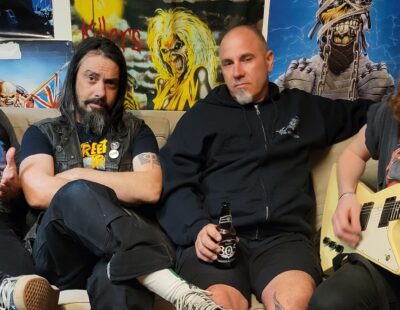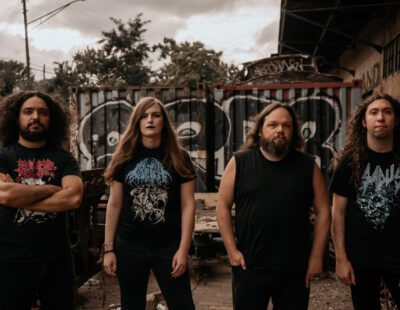
Back in 2013, we caught wind of a musical project that, at the time, just had to be a novelty. Goatcraft was the work of pianist Lonegoat, who professed to play death metal-inspired piano music that he dubbed “necroclassical.” Surely, we thought, this was a joke, a way of poking fun at current metal, a one-off with nowhere to go.
Then there was a second Goatcraft album, and rumors of another on the way. That third album, Yersinia Pestis, was not to arrive, though, until the middle of this year. In the September 2016 issue, we had the opportunity to find out from Lonegoat what that process was like, but we were unable to fit all of his comments into the magazine article. You can find the rest of the interview below, along with a stream of the new album. It might not inspire you to any goat-related violence, but it’s certainly more evidence that metal is some of the most expansive and inclusive music being made today, and all approaches are welcome.
You wrote this album twice. How is this version of the record different from the original? Did you write entirely new pieces, or are these reworked/improved versions of those original songs?
Most of the tracks from the original Yersinia Pestis album were cut. This wasn’t much different than Blasphemer as some of the content never made it on that album, too. But in terms of the amount of content culled, most of the original Yersinia Pestis went to the wayside. No regrets!
The Blasphemer was a relatively long, high-concept record, while Yersinia Pestis is quite a bit shorter… is it less highbrow than The Blasphemer?
Yes, Yersinia Pestis isn’t a deliberate highbrow offering. Its main focus is on the music whereas Blasphemer was a sparse, soundtrackish accompaniment to the artwork of William Blake; a duality of visual art and music. There’s less of a formal concept to Yersinia Pestis, but there are some liner notes where I juxtaposed the Black Death to other catastrophes, as well as featuring a running order of song titles to present a kind of narrative sequence where the imagination can envision the events unfold during a major calamity.
Can you talk a little about your progress between All For Naught and Blasphemer, and again between Blasphemer and Yersinia Pestis?
Each new album should surpass the prior, and attest the necessity to pass beyond the prior (and for the prior to perish in this junction).
Can you speak specifically about the musical differences between them and what compositional choices you make that relate to the rock/metal sound?
Metal is distinctly different than rock, so this question can be broken down a bit before addressing how it contrasts to classical. Loosely speaking, rock often employs a pop structure to be ‘easy listening’ and it is predominantly vocal-driven. The pianos/keyboards utilized in most rock bands are fluff and not far removed from carnival music. Most good metal is dissimilar because it took the instruments of rock, cranked the dial to 11, and discarded the apparent pop influence for an approach that challenged the listener, and stated that the world isn’t all dandelions and tulips. The early metal bands who used keyboards did so for the ambient, horror soundtrack, and neoclassical sounds and they used them to great successes to enhance their music. Of course, as metal became commercialized, the carnival music aspect was then assimilated into bands like Fleshgod Apocalypse and other birds of that feather. For classical, it’s entirely separate from metal. The only real similarity is how classical pieces go from point A to point B.
How often do you perform live?
I’ve played all around Texas and opened for bands like Negura Bunget, Absu, Imprecation, etc. Other than Texas gigs, one of my first performances was at the Day of Death festival in New York. Also, I was the opening band to play the first Housecore Horror Film Festival which Phil Anselmo and Corey Mitchell put together. Phil and Corey later wanted me to play the last night of the fest during the awards ceremony, which was very cool of them because this bestowed a second night to sling merch for extra beer & taco money. Overall, the fest was a good experience. Phil was hospitable and he didn’t seem like a racist like how the internet is making him out to be; he’s just a dude with a libido for binge partying. The nannies in metal like Kim Kelly and Neill Jameson should desist their advocation of this rising lynch mob mentality because they’re doing more damage than good. They’re making metal a social safe space when it should be a wild west. Let chaos reign!
Outside of regular shows and festivals, I’ve played on FM radio a couple of times in San Antonio, and one horror themed wedding last year. My live performances are similar to how I play alone at home. I’ll have a rough idea of what I’ll want to do, then I’ll execute it without sticking to a set list or anything like that. So, as a result of semi-improvisational performances, no two Goatcraft shows are the same. I’ll play whatever feels suiting that comes to mind. Goatcraft melodies are worked into live sets as I see appropriate, and I often stitch sections of different songs together. This is much more fun than playing the same songs over and over like a robot, and it keeps my mind feral.
What are your favorite songs to perform? Which songs are you most compositionally happy with?
The process of creating music vitalizes me; it’s akin to a stroll through a realm of cogitation; analogous of an extramundane abstraction funneled through an intramundane medium. Goatcraft would run afoul of reason’s proscription if I went into further details because there’s no possible rationale which could fully explain Goatcraft-as-it-is in regard to the elevation of Goatcraft-as-it-must-be. Therefore I must stop here.
How far would you like to take this project? Do you feel like there’s more you want to do in this style?
Goatcraft, at the moment, is a five album concept. The first letters from each album will eventually spell out “ABYSS”:
A)ll for Naught
B)lasphemer
Y)ersinia Pestis
S)
S)
Yersinia Pestis serves as an abutment of sorts between Blasphemer and the newer compositions that I’m working on. I’m not entirely sure if I will continue Goatcraft after five albums or if a successive incarnation of the project will be spawned (Goatcraft AD?).






